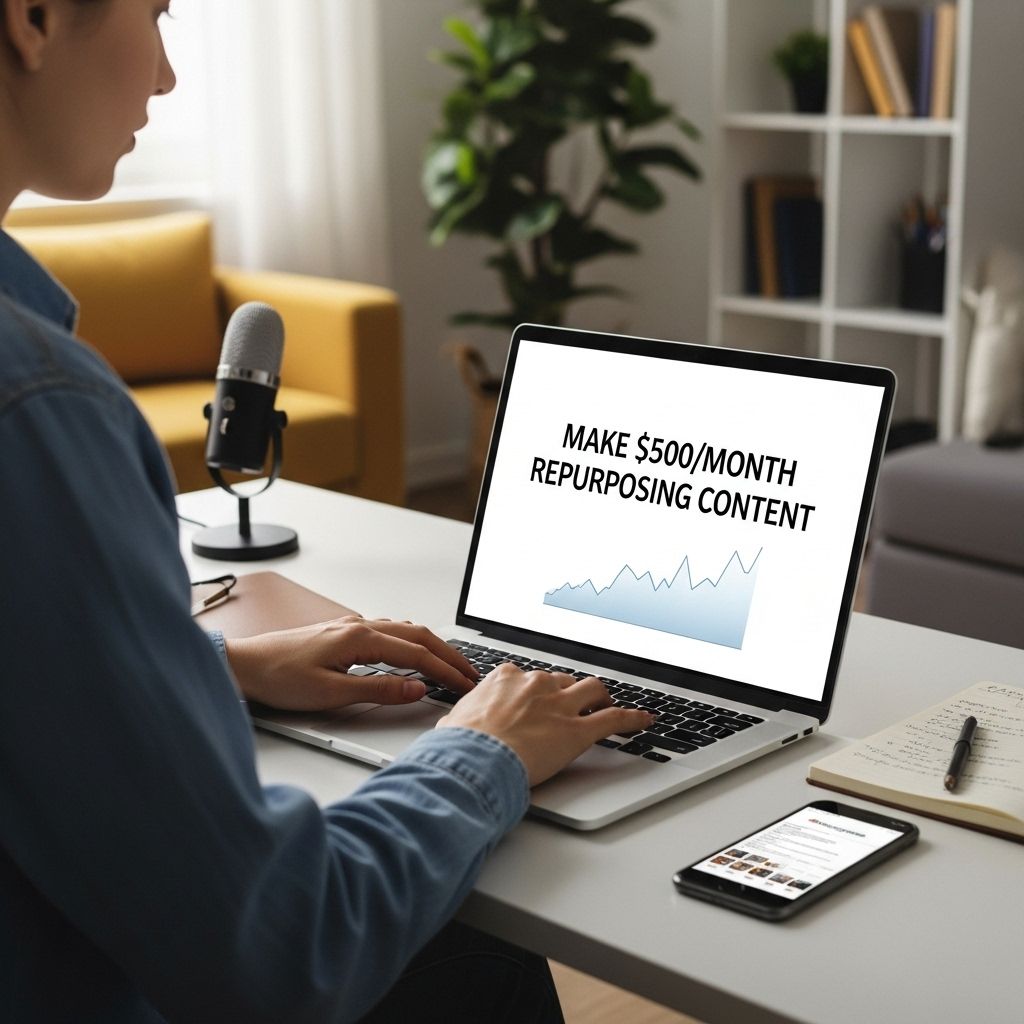In the fast-paced digital world, creating fresh content consistently can be a daunting task. However, there’s a hidden treasure in transforming existing content into new formats—this strategy is known as content repurposing. By repurposing content, not only can you save time and effort, but you can also maximize your reach and engagement. With the right approach, it’s entirely possible to generate a supplementary income of $500/month by leveraging your existing content.
What is Content Repurposing?
Content repurposing is the process of taking existing content and adapting it into different formats to reach broader audiences. This can involve converting blog posts into videos, turning podcasts into infographics, or even compiling social media posts into an ebook.
Why is Content Repurposing Important?
Repurposing content provides several benefits that can help you not just in saving time but also in enhancing your content marketing strategy:
- Increased Reach: Different formats appeal to different audiences. Some users prefer reading, while others engage more with video or audio.
- SEO Benefits: Repurposing can help you rank for various keywords by presenting the same information in different formats.
- Resource Optimization: Instead of starting from scratch, you can maximize the value of content you’ve already produced.
- Building Authority: Sharing valuable insights consistently helps establish you as an expert in your niche.
How to Get Started with Content Repurposing
Here’s a step-by-step guide on how to effectively repurpose your content:
Step 1: Audit Your Existing Content
Before diving into repurposing, take inventory of the existing content you have. Consider:
- Blog posts
- Social media posts
- Videos
- Podcasts
- Webinars
Identify high-performing content that resonates well with your audience.
Step 2: Choose New Formats
Once you have identified content to repurpose, determine the formats that best fit your audience’s preferences. Here are some popular options:
| Original Format | Repurposed Format |
|---|---|
| Blog Post | Video Tutorial |
| Podcast | Infographic |
| Webinar | eBook |
| Social Media Post | Slide Deck |
Step 3: Create a Repurposing Schedule
Consistency is key. Create a schedule for how often you’ll repurpose content. For example:
- Monday: Repurpose last week’s blog post into a video.
- Wednesday: Create an infographic based on the month’s podcasts.
- Friday: Compile social media tips into a checklist.
Monetizing Your Repurposed Content
Now that you have a strategy for content repurposing, the next step is monetization. Here are some effective methods:
1. Affiliate Marketing
Integrate affiliate links into your repurposed content. For instance, if you create a video tutorial based on a blog post, include relevant affiliate products or services within the video description.
2. Selling eBooks
Compile your repurposed content into an eBook. If you have several blog posts on a similar topic, you can create a comprehensive guide. Sell this eBook on your website or platforms like Amazon.
3. Subscription Models
Consider offering exclusive content through subscription models. For example, create premium videos or detailed guides available to subscribers only. Platforms like Patreon can facilitate this.
4. Online Courses
If you have substantial expertise on a topic, consider creating an online course. Use your existing content as course material, and monetize your knowledge.
Tips for Effective Content Repurposing
To ensure your content repurposing is effective, keep the following tips in mind:
- Maintain Quality: Ensure that repurposed content is as valuable as, if not more than, the original content.
- Keep Your Audience in Mind: Tailor each repurposed piece to the preferences and needs of your target audience.
- Use SEO Techniques: Optimize repurposed pieces with relevant keywords to enhance visibility.
- Promote Across Platforms: Share your repurposed content on various platforms to maximize reach.
Tools for Content Repurposing
Several tools can assist you in your content repurposing journey:
1. Canva
A great graphic design tool for creating infographics, social media posts, and more.
2. Lumen5
This tool helps you turn blog posts into engaging videos effortlessly.
3. Snappa
Use Snappa to create visually appealing graphics for your repurposed content.
4. Hootsuite
Plan and schedule your repurposed content across social media platforms using Hootsuite.
Tracking Your Progress
As you begin to implement your content repurposing strategy, it’s crucial to track your progress:
- Use analytics tools to monitor engagement and reach.
- Evaluate which types of repurposed content perform best.
- Refine your strategy based on data insights.
Conclusion
Content repurposing is a powerful strategy that can help you save time, increase visibility, and create additional income streams. By auditing your existing content, selecting appropriate formats for repurposing, and exploring various monetization strategies, you can create a sustainable revenue model. As you become more skilled at repurposing, reaching that $500/month goal could become a reality sooner than you think. Start today, and unlock the potential of your existing content!
FAQ
What is content repurposing?
Content repurposing involves taking existing content and modifying it for different formats or platforms to reach a wider audience.
How can I make $500 a month repurposing content?
You can make $500 a month by offering content repurposing services to businesses, creating multiple formats for their existing content, and charging a fee for each project.
What types of content can be repurposed?
Blogs, videos, podcasts, infographics, and social media posts can all be repurposed into different formats to maximize their value and reach.
What skills do I need to repurpose content effectively?
You should have good writing skills, an understanding of various content formats, and basic graphic design or video editing skills to effectively repurpose content.
Where can I find clients for content repurposing?
You can find clients on freelance platforms, social media, or by networking with businesses that have existing content but lack the time or expertise to repurpose it.
How do I set my rates for content repurposing services?
You can set your rates based on the complexity of the content, the time required for repurposing, and market rates for similar services in your industry.




